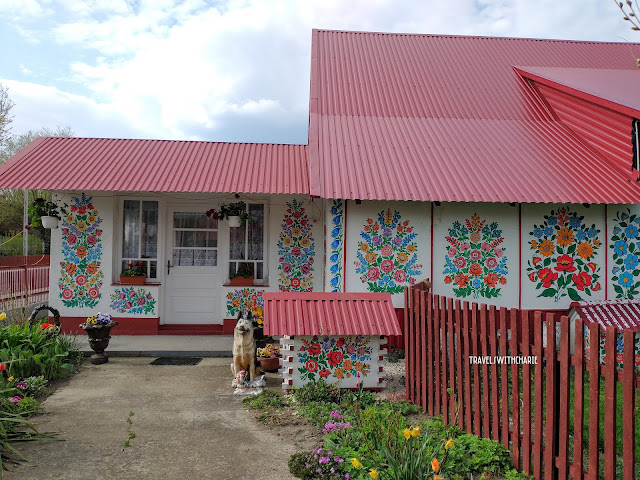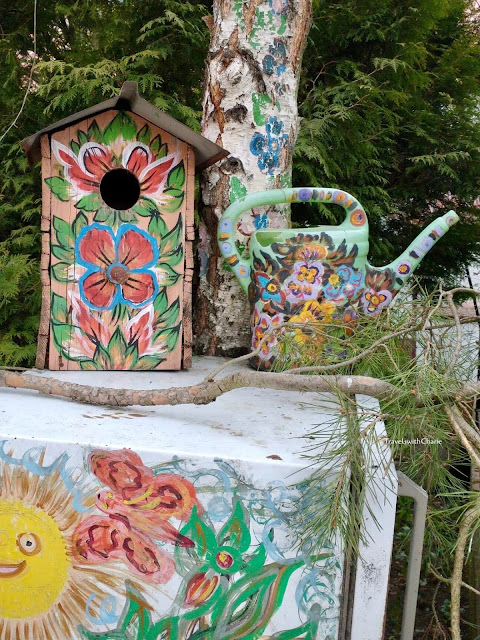The tradition of painting flowers on both the interior and exterior surfaces of a house started in the late 19th century in the small, rural village of Zalipie in Southern Poland. It was done primarily to cover-up soot marks. What was a simple paint job developed into colorful floral patterns.
Dog kennels are no exceptions.
The back of the house is not left out.
Several barns in Zalipie are also painted with flowers. I noticed that barns are painted with white flowers, perhaps in contrast to the black background.
The most famous among local artists was Felicji Curiłowej. Her house is now a museum where her exuberant artistry is on display.
Detail of floral pattern.
Pink and blue, cute as you. Here’s another house in the Museum compound.
Zalipie is a quiet village surrounded by lush, green fields. The older houses are alive with painted flowers.
This well was lovingly painted.
Even the fence didn’t escape the artist’s palette.
I visited this property where an artist lives and which is open to the public. Her daughter welcomed us to the studio where I bought painted wooden souvenirs.
The artist’s garden is full of whimsical things.
The Church of St. Joseph has beautifully painted columns and walls.
Dom Malarek garden
Dom Malarek or the House of Women Painters is a community center where you can view folk art and the works of contemporary artists, participate in painting workshops as well as get information about local traditions and crafts. Unfortunately, I wasn't able to get in as I got there late. But the garden was open.
This pail is a work of art.
Zalipie Village is definitely one of the prettiest villages in Poland. It’s only 63 miles from Krakow yet a world away. I found the tranquility appealing and the residents were friendly and welcomed me inside their properties so I could take photos of the floral decor.
The annual Malowana Chata (Painted Cottage) contest will be held in June 2022.
How to get there:
The easiest way would be to join a group tour. I tried to do this but they canceled my paid reservation probably because no one else signed up. They usually require a minimum number of passengers to operate the tour.
The second option is to rent a car and drive to Zalipie. It takes about an hour and a half to get there from Krakow.
The third option is to take a bus but I studied the schedule and the buses to Zalipie from Tarnow are few and there are no buses leaving Zalipie after 5:30 p.m. on weekdays. There are no bus services on weekends until further notice. Bus schedule: http://zalipie.tarnow.travel/en/getting-here-tarnow-zalipie/
The last option is to take the train to Tarnow from Krakow then Uber or taxi to Zalipie. I took the train for 12PLN from Krakow and fully expected to take Uber from Tarnow to Zalipie but there weren't any Uber drivers around. So I took a taxi instead and had the driver take me around Zalipie so I could see the painted houses. This taxi ride cost me approximately $50.00, a bargain compared to the $120.00 charged by the organized tour. I called Viva Taxi (whose number I found at the train station) and they arranged for a driver to pick me up in front of the station. I was impressed and pleased with my driver who was patient and drove carefully and also made inquiries from locals where to find the painted houses. I don’t speak Polish so the driver and I communicated through Google translate. I’m so grateful he helped me make this dream visit to Zalipie happen. The taxi company has a website and app for making reservations: taxi-viva.pl
Directions to Felicji Curyłowej Museum (best place to start your visit)
*****
Images by TravelswithCharie

















